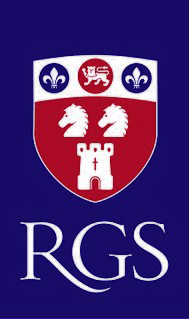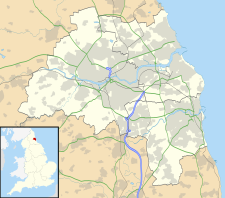
Newcastle upon Tyne, commonly known as Newcastle, is a city in Tyne and Wear, North East England, 103 miles (166 km) south of Edinburgh and 277 miles (446 km) north of London on the northern bank of the River Tyne, 8.5 mi (13.7 km) from the North Sea. Newcastle is the most populous city in the North East, and forms the core of the Tyneside conurbation, the eighth most populous urban area in the United Kingdom. Newcastle is a member of the UK Core Cities Group and is a member of the Eurocities network of European cities.

Jesmond Dene, a public park in the east end of Newcastle upon Tyne, England, occupies the narrow steep-sided valley of a small river known as the Ouseburn, flowing south to join the River Tyne: in north-east England, such valleys are commonly known as denes. In fact the name 'Jesmond' means 'mouth of the Ouseburn'.
Charles Mitchell was a Scottish engineer from Aberdeen who founded major shipbuilding yards on the Tyne. He became a public benefactor who funded notable buildings that still survive today.
John Dobson was a 19th-century English architect in the neoclassical tradition. He became the most noted architect in the North of England. Churches and houses by him dot the North East - Nunnykirk Hall, Meldon Park, Mitford Hall, Lilburn Tower, St John the Baptist Church in Otterburn, Northumberland, and Beaufront Castle among them. During his career he designed more than 50 churches and 100 private houses. However, he is best known for designing Newcastle railway station and for his work with Richard Grainger developing the centre of Newcastle in a neoclassical style.

The Royal Grammar School, Newcastle upon Tyne, usually abbreviated as RGS, is a selective British independent school for pupils aged between 7 and 18 years. Founded in 1525 by Thomas Horsley, the Mayor of Newcastle upon Tyne, it received royal foundation by Queen Elizabeth I and is the city's oldest institution of learning. It is one of 7 schools in the United Kingdom to bear the name "Royal Grammar School", of which two others are part of the independent sector.

Jesmond Parish Church is a parish church in the Church of England situated in Brandling Village in the Jesmond suburb of Newcastle upon Tyne, England. The church's official name is the Clayton Memorial Church and is unusual among Anglican parish churches in not being named after either a saint who appears in the church's calendar or a person of the Trinity. This reflects the church's conservative Evangelical roots.

The history of Newcastle upon Tyne dates back almost 2,000 years, during which it has been controlled by the Romans, the Angles and the Norsemen amongst others. Originally known by its Roman name Pons Aelius, the name "Newcastle" has been used since the Norman conquest of England. Due to its prime location on the River Tyne, the town developed greatly during the Middle Ages and it was to play a major role in the Industrial Revolution, being granted city status in 1882. Today, the city is a major retail, commercial and cultural centre.

The Freeman Hospital is an 800-bed tertiary referral centre in Newcastle upon Tyne, England. The hospital is managed by the Newcastle upon Tyne Hospitals NHS Foundation Trust and is a teaching hospital for the University of Newcastle upon Tyne.

West Jesmond is a station on the Tyne and Wear Metro, and one of three stations serving the suburb of Jesmond in Newcastle upon Tyne. The Tyne and Wear Metro station at West Jesmond was opened in August 1980.

St Columba's Church is one of the two London congregations of the Church of Scotland. The church building, designed by Sir Edward Maufe, is located in Pont Street, Knightsbridge, near Harrod's department store. It was given Grade II listing by English Heritage in 1988.
Newcastle High School for Girls is an independent day school for girls aged 3–18 in Newcastle upon Tyne, England. The Junior School is at Sandyford Park and the Senior School is located in the neighbouring suburb of Jesmond.

La Sagesse School was a 3–16, Roman Catholic, independent school for girls in Jesmond, Newcastle upon Tyne, Tyne and Wear, England. It was established in 1906 and closed in 2008. It occupied Jesmond Towers, a Grade II* listed building and was located in the Roman Catholic Diocese of Hexham and Newcastle.

Jesmond Park Academy is a coeducational secondary school and sixth form located in Heaton, Newcastle upon Tyne, England.

Jesmond is a station on the Tyne and Wear Metro, and one of three stations serving the suburb of Jesmond in Newcastle upon Tyne. The Tyne and Wear Metro station at Jesmond was opened in August 1980, and was purpose-built for the Metro.

The Royal Victoria Infirmary (RVI) is a 673-bed tertiary referral centre in Newcastle upon Tyne, England. The hospital is part of the Newcastle upon Tyne Hospitals NHS Foundation Trust and is a teaching hospital for the University of Newcastle upon Tyne.

Jesmond Dene House is a 19th-century mansion house at Jesmond Dene, Newcastle upon Tyne, England which is now a hotel. It is a Grade II listed building.

Newcastle City Centre, is the city centre of Newcastle upon Tyne, England. Newcastle city centre is the historical heart of the city and the main cultural and commercial centre of North East England. Along with nearby Gateshead town centre, which lies on the opposite side of the River Tyne, the city centre forms the central core of the Tyneside conurbation.

Jesmond is a largely residential suburb immediately to the north of Newcastle upon Tyne city centre, in North East England. It has a population of about 12,000 and is split into two electoral wards. Historically part of Northumberland, it is adjacent to the East side of the Town Moor, providing pedestrian and cycle paths to Spital Tongues and the city's two universities. It is widely considered to be the most affluent suburb of Newcastle and is home to a large student population.

Fernwood House is a Victorian building, located in Newcastle Upon Tyne, United Kingdom. The building is regarded as one of the oldest and most notable buildings still standing in the area of Jesmond. The building is located on Clayton Road in Jesmond and was commissioned in 1864 by James Stoddard. Construction of Fernwood House was completed in February 1865. Shortly after its completion, it was sold to tea dealer, William Stewart. Stewart served as the Sheriff of Newcastle between 1876 and 1877, while living in the house.

The Princess Mary Maternity Hospital was a health facility in Jesmond, Newcastle upon Tyne. It is a Grade II listed building.



















